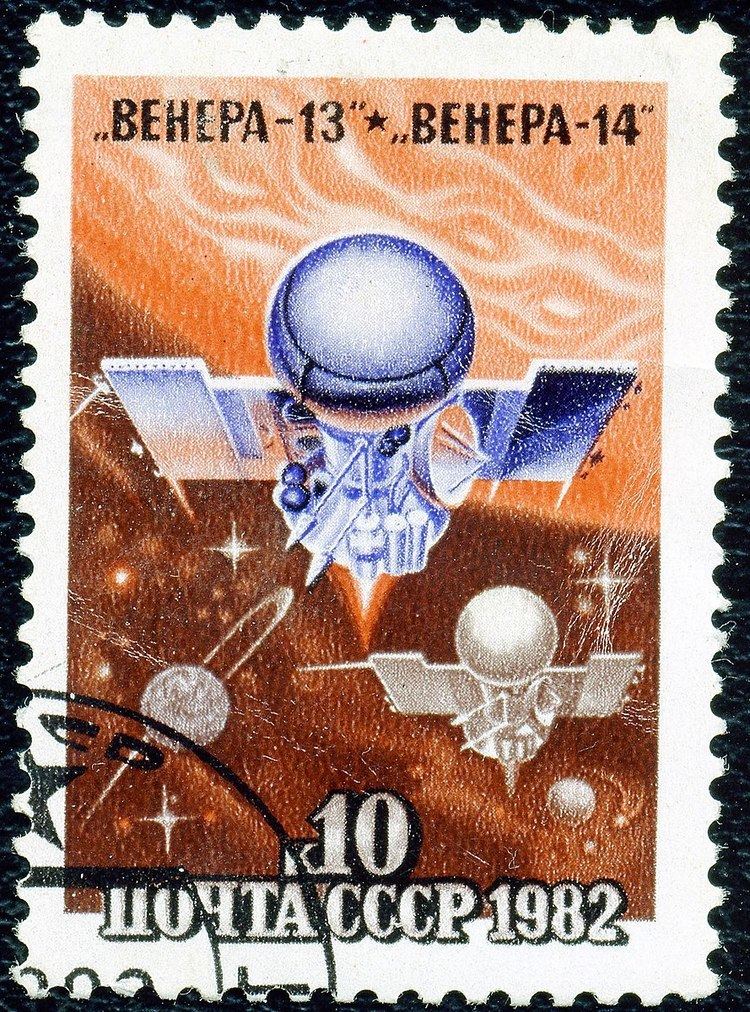SATCAT no. 1292715599 | COSPAR ID 1981-106A1981-106D Spacecraft type 4V-1 no.760 | |
 | ||
Mission duration Travel: 5 monthsLander: 127 minutes | ||
Venera 13 (Russian: Венера-13 meaning Venus 13) was a probe in the Soviet Venera program for the exploration of Venus.
Contents
Venera 13 and 14 were identical spacecraft built to take advantage of the 1981 Venus launch opportunity and launched 5 days apart, Venera 13 on 30 October 1981 at 06:04:00 UTC and Venera 14 on 4 November 1981 at 05:31:00 UTC, both with an on-orbit dry mass of 760 kg.
Design
Each mission consisted of a cruise stage and an attached descent craft.
Cruise stage
As the cruise stage flew by Venus the bus acted as a data relay for the lander and then continued on into a heliocentric orbit. It was equipped with a gamma-ray spectrometer, UV grating monochromator, electron and proton spectrometers, gamma-ray burst detectors, solar wind plasma detectors, and two-frequency transmitters which made measurements before, during, and after the Venus flyby.
Descent lander
The descent lander was a hermetically-sealed pressure vessel, which contained most of the instrumentation and electronics, mounted on a ring-shaped landing platform and topped by an antenna. The design was similar to the earlier Venera 9–12 landers. It carried instruments to take chemical and isotopic measurements, monitor the spectrum of scattered sunlight, and record electric discharges during its descent phase through the Venusian atmosphere. The spacecraft utilized a camera system, an X-ray fluorescence spectrometer, a screw drill and surface sampler, a dynamic penetrometer, and a seismometer to conduct investigations on the surface.
List of lander experiments and instruments:
Landing
After launch and a four-month cruise to Venus the descent vehicle separated from the cruise stage and plunged into the Venusian atmosphere on 1 March 1982. After entering the atmosphere a parachute was deployed. At an altitude of about 50 km the parachute was released and simple airbraking was used the rest of the way to the surface.
Venera 13 landed at 7.5°S 303°E / -7.5; 303, about 950 km northeast of Venera 14, just east of the eastern extension of an elevated region known as Phoebe Regio.
The lander had cameras to take pictures of the ground and spring-loaded arms to measure the compressibility of the soil. The quartz camera windows were covered by lens caps which popped off after descent.
The area was composed of bedrock outcrops surrounded by dark, fine-grained soil. After landing, an imaging panorama was started and a mechanical drilling arm reached to the surface and obtained a sample, which was deposited in a hermetically sealed chamber, maintained at 30 °C and a pressure of about 0.05 atmosphere (5 kPa). The composition of the sample determined by the X-ray fluorescence spectrometer put it in the class of weakly differentiated melanocratic alkaline gabbroids.
The lander functioned for 127 minutes (the planned design life was 32 minutes) in an environment with a temperature of 457 °C (855 °F) and a pressure of 89 Earth atmospheres (9.0 MPa). The descent vehicle transmitted data to the satellite, which acted as a data relay as it flew by Venus.
Suggested photographic evidence of life
Leonid Ksanfomaliti[:ru] of Space Research Institute of the Russian Academy of Sciences (a contributor to the Venera mission) and Stan Karaszewski of Karas, suggested signs of life in the Venera images in an article published in Solar System Research. According to Ksanfomaliti, certain objects resembled a "disk", a "black flap" and a "scorpion" which "emerge, fluctuate and disappear", referring to their changing location on different photographs and traces on the ground.
Engineers familiar with the probe have identified the moving "disk" as actually being the two lens caps ejected from the lander. Rather than a single object that had moved between two different places, they are simply two inanimate similar-looking objects in different places. The other "objects" are ascribed to image processing artifacts and do not appear in the original photography.
The editors of Solar System Research published an editorial comment and a number of commentary articles from other scientists in their September 2012 publication of Issue 5, Volume 46 of the journal. That issue also includes a second article from Ksanfomaliti, in which he claims to identify several other life forms and speculates regarding the apparent rich diversity of life around the landing site.
These claims have been refuted by the Live Science website.
